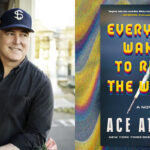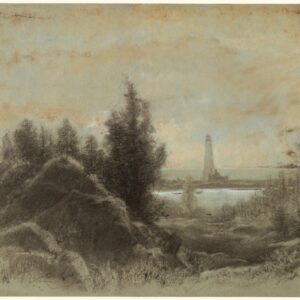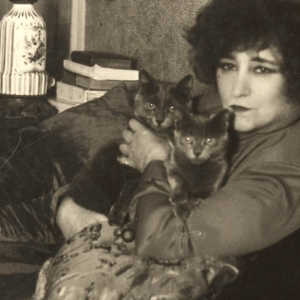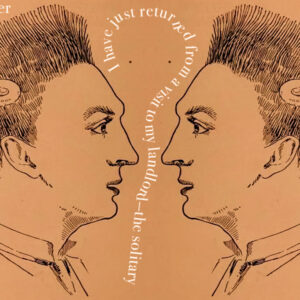
An American Faerie Queene: The Uncertain Lives of Nathaniel and Una Hawthorne
Megan Marshall on Nathaniel Hawthorne’s Family, Edmund Spenser, and Biographical Lies
Una Hawthorne was calling to me. I’d ended my book with her birth, but I hadn’t closed my mind to her presence in the sources I’d consulted while researching her parents’ lives and reconstructing the love story that played a prominent role in my narrative—a romance that seemed surprisingly modern.
The Hawthornes met after each had served a solitary apprenticeship of a decade or more in their profession. Nathaniel Hawthorne was among the first American writers of fiction to attempt to make a living by his pen; lack of a steady income was the reason for his three-year secret engagement to Sophia Peabody, the gifted painter who’d won his heart with a sketch of one of his characters.
They didn’t cohabit, as a pair of artists might today, but they considered themselves married from the date of their engagement and addressed each other in passionate love letters as husband and wife. When at last they planned a wedding in July 1842, Nathaniel joked that in performing the ceremony the minister would have to “thrust himself between” them.
Over the objections of friends, who worried the choice was “too imaginative,” the couple adhered to a decision, made before the child’s birth, to name her for the uncommonly virtuous heroine of Edmund Spenser’s epic poem The Faerie Queene.
The Hawthornes were older parents with a penchant for idealizing themselves and the Edenic surroundings into which their first child was born, a veritable “fairy-land” on the banks of the Concord River, “sheltered from the turmoil of life’s ocean,” in Nathaniel’s terms.
Sophia had suffered a miscarriage during an otherwise blissful honeymoon year, and she recorded the loss in words etched with the diamond on her wedding ring into a windowpane of the “moss-grown country parsonage” her husband dubbed the “Old Manse,” rented out to them by their near neighbor Ralph Waldo Emerson: “Man’s accidents are God’s purposes.” Una’s arrival during the second year of their marriage must have been by divine intent.
Over the objections of friends, who worried the choice was “too imaginative,” the couple adhered to a decision, made before the child’s birth, to name her for the uncommonly virtuous heroine of Edmund Spenser’s epic poem The Faerie Queene, the king’s “onely daughter deare.” Nathaniel agreed there was risk in selecting a name that “has never before been warmed with human life,” but in her first weeks Una’s living presence had given it “a natural warmth,” her father claimed.
He expected that “when she has worn it through her lifetime, and perhaps transmitted it to descendants of her own, this beautiful name will have become naturalized on earth;—whereby we shall have done a good deed in first bringing it out of the realm of Faery.”
Yet the months after Una’s birth brought hardship. Sophia nursed her baby and soon also another little girl born that year in Concord to Margaret Fuller’s sister Ellen, whose breast milk failed. Nathaniel sold stories to magazines, but payment was minimal and erratic.
By winter, Nathaniel’s need for paying work in the form of a political appointment—ultimately, a customs-house job—drove the Hawthornes from their country retreat. They made plans to move to Salem and a house they’d share with Nathaniel’s widowed mother and two unmarried sisters.
The story had always seemed improbable to me.
There would be more Hawthorne children, but only Una had been born during “the calm summer of my heart and mind,” as Nathaniel described the Old Manse years in the introduction to his collection of stories published after the move in hopes of recouping his losses. Sophia left behind a second inscription on a windowpane, marking the former rectory with an indelible image of Una’s infant happiness.
I read the delicate tracings myself on the day of the reinterment:
Una Hawthorne
stood on this
window sill
January 22’d 1845
while the trees
were all
glass chandeliers a
goodly show which
she liked much tho’
only Ten months old
Another vision of Una had stayed with me, from a book published in the 1950s by the Columbia professor Vernon Loggins called The Hawthornes. Loggins traced the genealogy of the family through seven generations, beginning with Nathaniel’s colonial ancestors and ending with his daughters, Una and Rose, and their middle sibling, Julian.
In the final chapters, Loggins described Una’s death, a little over three decades after her auspicious birth. By then both Hawthorne parents were dead, and both Rose and Julian had married.
Una herself was engaged to a writer of short stories, Albert Webster. While visiting Julian’s family at their home on the outskirts of London, Una received word that the tubercular Webster had succumbed to illness on a ship bound for Hawaii, where he’d hoped to regain his health in advance of their wedding.
During the next several months, Una’s auburn hair “turned completely white,” Loggins wrote, “and the least physical exertion caused fatigue.” Una left Julian’s house for a rest stay at an Anglican convent near Windsor where, within days, “she suddenly grew very weak. A message was sent to Julian, but before he arrived she was no more.”
The story had always seemed improbable to me. Then, by chance, I’d seen Una’s hair, and it was not white. Someone was lying.
______________________________

Excerpted from the book After Lives: On Biography and the Mysteries of the Human Heart by Megan Marshall. Copyright © 2025 by Megan Marshall. From Mariner Books, an imprint of HarperCollins Publishers. Reprinted by permission.
Megan Marshall
Megan Marshall is the Pulitzer Prize-winning author of Margaret Fuller: A New American Life, Elizabeth Bishop: A Miracle for Breakfast, and The Peabody Sisters, a Pulitzer Prize finalist. Her most recent book is the essay collection, After Lives: On Biography and the Mysteries of the Human Heart.



















